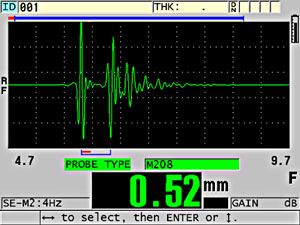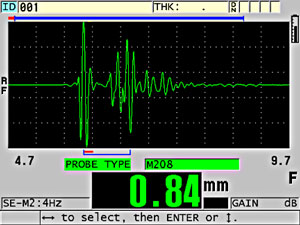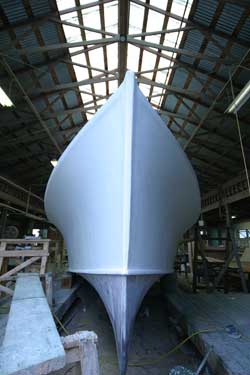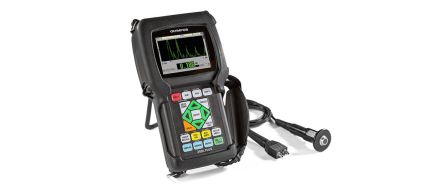Mesure de l’épaisseur de l’enduit gélifié sur de la fibre de verreL’enduit gélifié est un revêtement en résine polyester dure qui est appliqué sur la fibre de verre structurelle. Il constitue une surface protectrice lisse et brillante qui élimine les frottements et améliore l’apparence. Il est couramment utilisé sur les coques de bateaux en fibre de verre et sur les équipements de salle de bain tels que les éviers, les baignoires et les cabines de douche. Les fabricants de produits en fibre de verre doivent mesurer l’épaisseur de l’enduit gélifié pour s’assurer qu’elle se situe dans une certaine étendue. En particulier, il est important de détecter les endroits où l’enduit n’est pas assez épais, que ce soit en raison d’une application insuffisante ou d’un retrait. Les mesures varient généralement entre 0,25 à 1 mm (0,01 à 0,04 po), avec une épaisseur nominale d’environ 0,5 mm (0,02 po) dans la plupart des cas. Équipement de mesure d’épaisseur des enduits gélifiésL’épaisseur d’un enduit gélifié peut être mesurée à l’aide de mesureurs d’épaisseur de précision, comme les mesureurs 39DL PLUS™ et 45MG avec option logicielle pour sonde monoélément. L’affichage de la forme d’onde, qui est inclus sur le mesureur 39DL PLUS et offert en option pour le mesureur 45MG, est utile pour connaître la qualité de l’écho et pour vérifier les lectures. |
On mesure normalement un enduit gélifié au moyen d’une sonde à ligne à retard. La sonde la plus couramment recommandée est la M208-RM (20 MHz, diamètre d’élément de 0,125 po). Dans les cas où l’enduit est épais, on peut aussi utiliser la sonde M202-RM (10 MHz, diamètre d’élément de 0,25 po).
Procédure à suivre pour mesurer l’épaisseur de l’enduit gélifié sur de la fibre de verre
Cette application nécessite une mesure en mode 2 (de l’écho d’interface jusqu’au premier écho de fond). La principale difficulté réside dans le fait que la surface intérieure de l’enduit gélifié est généralement rugueuse et irrégulière, épousant le profil de la surface de la fibre de verre. En raison de cette géométrie non uniforme, la qualité de l’écho provenant de l’interface enduit/fibre de verre varie souvent considérablement d’un point à l’autre. Il est possible que le premier écho provenant de cette interface ne soit pas le plus important, et une distorsion de phase peut apparaître, inversant les échos. Dans certains cas, la rugosité peut faire chuter l’amplitude de l’écho réfléchi en dessous du minimum détectable. De plus, l’écho provenant de l’interface enduit/fibre de verre est généralement suivi de plusieurs autres crêtes représentant le bruit de diffusion provenant de la fibre de verre sous-jacente. Ce bruit entraînera des lectures erronées s’il est détecté.
Comme les fabricants sont souvent principalement soucieux de confirmer que l’enduit gélifié respecte une spécification d’épaisseur minimale, la procédure recommandée consiste à effectuer plusieurs relevés dans une petite zone et à enregistrer la lecture la plus basse obtenue. Si l’affichage de la forme d’onde est disponible, il est possible de vérifier si le premier écho de retour (représentant l’épaisseur minimale de l’enduit gélifié) est détecté en surveillant la forme d’onde, comme le montrent les images d’écran ci-dessous.
Si un mesureur 45MG est utilisé sans l’option d’affichage de la forme d’onde, il est particulièrement important de noter la valeur minimale dans une zone locale. Toute transition abrupte vers une lecture plus élevée représente généralement une fausse détection causée par des échos irréguliers. En règle générale, le gain du mesureur doit être réglé à un niveau élevé pour
maximiser la probabilité de détecter le premier écho de retour. Le mode de détection de la première crête, disponible sur la plupart de nos modèles de mesureurs, est également utile dans cette application pour garantir la mesure de l’épaisseur minimale.

Exemple de lecture optimale d’un enduit gélifié. La première crête est détectée.

Exemple de lecture incorrecte. La première crête n’est pas détectée en raison de sa faible amplitude attribuable à la rugosité de la surface intérieure.
Mesure de l’épaisseur totale de la fibre de verre
Dans de nombreux cas, le même mesureur utilisé pour mesurer l’enduit gélifié peut également servir à mesurer l’épaisseur totale de la paroi (enduit et fibre de verre) en utilisant une seconde sonde, généralement une M1036 (2,25 MHz, diamètre d’élément de 0,5 po, haute sensibilité). L’épaisseur maximale mesurable de la fibre de verre est généralement d’environ 12,5 mm
(0,5 po). Pour des fibres de verre plus épaisses, un mesureur à haute pénétration (HP) est généralement nécessaire.
 Cette note d’application explique comment mesurer l’épaisseur de l’enduit gélifié appliqué sur de la fibre de verre.
Cette note d’application explique comment mesurer l’épaisseur de l’enduit gélifié appliqué sur de la fibre de verre.



